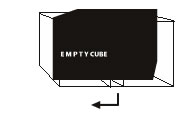LUÍS PAULO COSTA
OCTOBER 11, 2012

CONTACTS
www.cristinaguerra.com
EXHIBITION INFORMATION
ONE NIGHT
mirror, empty bottles and acrylic on cardboard boxes and paper bag, 2012
230 X 300 X 120 cm
A differentiating element: one night
Luís Paulo Costa’s work has been a sometimes quite discreet platform for the discussion and confrontation of views on such issues as the representational limits of painting or the status of the image as a multiple and its reduction to the condition of being a model for painting. Those who follow his work with a measure of nearness and regularity will be familiar with the paintings on canvas that invite us to revisit everyday scenes and moments, contaminated by photographic (more recently, digital) images the artist has found during his wanderings; in them, he searches for an element (Barthes’ punctum?) or chromatic tone that is intrinsically relevant to the painter’s labour, generating an absolute urge to return to the work of painting as a task that will regenerate the possibility of truth being brought before the viewer’s eye. In Luís Paulo Costa’s work, this idea of truth is partially present in imperfections and details, elements the author considers to be features of the possible representation of reality, that is to say, in painting’s capacity to develop, within the viewer’s mind, a layer of depth out of the depicted event that overlaps the plane of the photographic image as documental reference. However, Luís Paulo Costa’s appropriation of images and objects into the universe of painting is not limited to the technical action of applying a pictorial layer on them (the images or objects). Instead, the artist acts as a differentiating element that uses the artistic act to reformulate the condition of the gaze, fragmenting it into a variable of categories that circulate among the attentive observer, the viewer who looks for an overview of the event or the voyeur who avoids the image’s totality and looks for a particular, apparently less visible, sign. It is within the scope of this aesthetic and critical field that the ‘uma noite’ [one night] project, created by Luís Paulo Costa for EMPTY CUBE, starts by drawing our attention to the polysemic qualities of language as a semantic act and tool. What seems at first an irony, or a tautology at best, is actually part and parcel of the project’s process. A one-night exhibition, in a single presentation of one night, under the title ‘one night,’ the contents of which are displayed as a heap of leavings and leftovers set aside and destined to some place else, wherever it might be. Now, it falls to us to gauge the qualities of the objects featured there, like for instance the cardboard boxes containing bottles and other elements of the work. Secondly, what that night can project onto our imagination as a double of itself is part of Narcissus’ metaphor, as shown by the mirror that covers one of the walls of the cube which the work is installed. It is, indeed, in that reflection of itself, or of what is left of it, that we come into contact with the subject of the double, an issue the artist systematically brings before us in each one of his works, every time he paints an object, recreating it as an ‘other’ of itself that occupies the exact same space, making it impossible to compare the painted depiction with its model. Here we have a symbolic word of caution regarding painting as a representation that, instead of offering back the represented object, takes the form of an organic skin that reconstructs the object by refocusing the eye on the truth of images, irrespective of any models, canons, or the temporal correlations of its meaning. Though apparently different, its reflection is the condition of its possibility as both a place and an image.






